The Story Cards Program
A large number of children in rural schools are first generation learners without books at home or access to good libraries. Text books are the only reading material available to them.
There is a growing body of research which says that when children have access to a wide variety of stories their reading skills improve and they learn language with ease. Yet there is a dearth of easily accessible story books and supplementary reading materials in most primary schools.
The aim of the story cards project is to promote reading among underprivileged children in schools. One Story Card set is a collection of 100 illustrated four page A-3 sized laminated reading cards with stories from India and many other countries. It includes traditional folktales as well as modern stories, nature stories and stories about everyday experience. Interspersed among the stories are groups of riddles requiring ingenuity and careful thinking for their solution.
The story cards were originally published in Tamil, in 2003, as “Kathai Aruvi.” The collection was born out of the desire of four educationists, Ms. P. Saraswati, Ms. V. Vijayakanthi, Dr. L.S. Saraswathi and Prof. S. Rajalakshmi, to provide rural children with access to good reading material. Subsequently they were brought out in other Indian languages (Hindi, Marathi, Kannada Oriya) called “Katha Jharna”, and in English called “A Cascade of Stories”.
The preparation of the cards included collection, review and analysis of a large number of folktales and other traditional stories from within and outside of India. Those that were chosen were adapted keeping in mind the four page format of the cards. Great importance was given to illustrations in order to provide the right setting and bring each story to life.
The collection also included 8 cards with riddles commonly told in Tamil Nadu. The riddles are grouped by topic – animals, birds, trees, insects, etc.
Overall, the project took more than a year and a half to complete, including research, writing, field testing and rewriting. The first Tamil edition was published by Chatnath Trust, Chennai.
The Story Cards are presently available in Tamil, Hindi, English,Kannada, Marathi and Oriya.
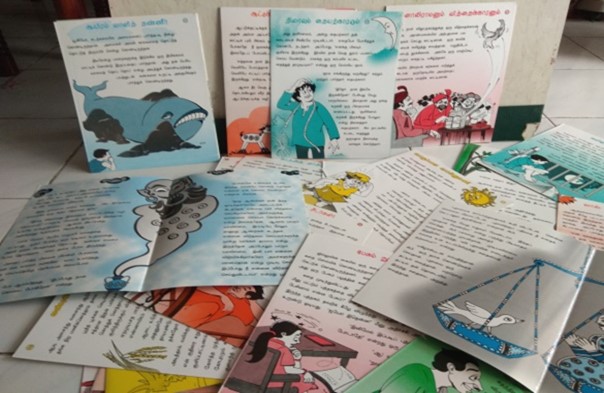 |
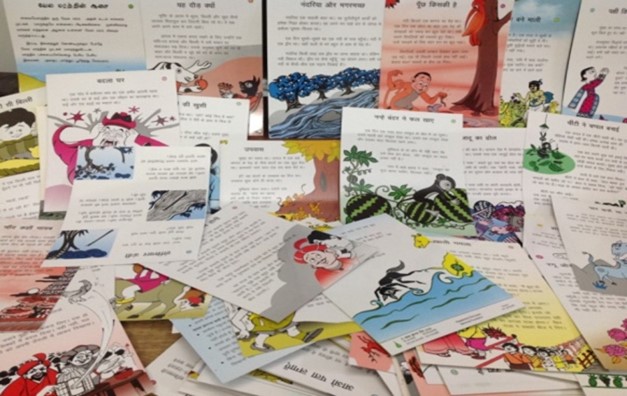 |
Features of the Story Cards
- The collection is printed on laminated A3 cards folded into 4-sided booklets.
- The cards are sturdy enough for intensive hands-on use.
- Several groups of children in a classroom can use them simultaneously.
- With students of younger ages, they can be read aloud by the teacher and used as the basis for skits, activities or games.
- The stories are in bold print with colourful illustrations and the aim was to bring good quality reading material at reasonable cost within the reach of under-privileged children.
- The stories are written in simple language for primary classes and serve as attractive supplementary reading materials
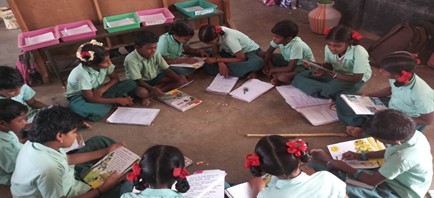
From a village school in Tamil Nadu
The Impact of the Story Cards
-
Many teachers and parents saw Kathai Aruvi as a priceless collection. Though the story cards were originally conceived to meet the educational needs of children in Tamil Medium Schools, they had a universal appeal cutting across language and cultural barriers.
-
The stories were translated and published in Hindi in 2008 when Room To Read, New Delhi, wanted to distribute a few thousand sets to its libraries and projects in Northern India. It was translated into Kannada by teachers of TVS academy, Tumkur, Karnataka in 2007. The Kannada stories were published in card format much later in 2018. America India Foundation got some stories translated into Odiya, Gujarati, and tribal languages for distribution to govt. schools and those were published in 2012. Parag,Tata Trust has supported the translation of the cards into Marathi in 2021.
-
The Association for the Blind, Madurai, Tamil Nadu has brought out the stories in Braille and has been using them for several years. The story cards have been used in adult literacy centres to develop interest in reading and writing among neo-literates.
-
Katha Jharna, the Hindi story card set, is one of the “Recommended Books” for Kendriya Vidyalaya Schools.
-
More than 13,000 sets of KathaiAruvi/Katha Jharna have reached different corners of the country over the years impacting over a lakh of children. A number of organizations like Save the Children Fund, Room To Read, AIF, Azim Premji Foundation, OELP, Doosra Dashak, Tata Trust, India Literacy Project to name a few, have distributed the Kathai Aruvi and Katha Jharna story cards sets free of cost to several government schools and libraries in remote areas, across the country. A few corporates too have sponsored the story cards sets to govt. schools in various blocks of Tamil Nadu.
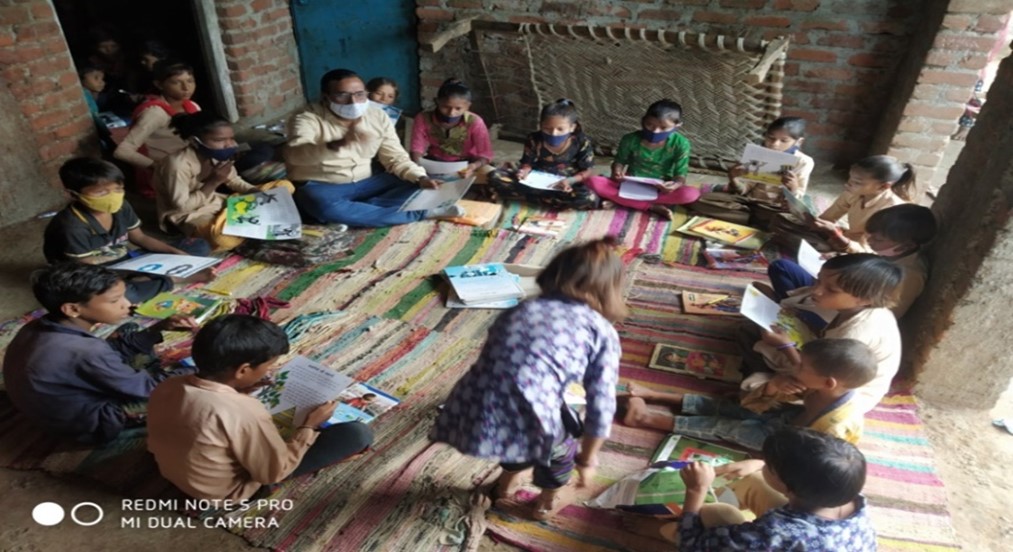
From a Tribal village in Rajasthan
-
The Tamil story cards were distributed to a wide range of children’s homes and orphanages in Tamil Nadu in collaboration with Dept. of Social Defence, TN.
-
Recently, based on requests from several educationists, Kathai Aruvi was translated into English for the benefit of English learners. The English story cards called, A Cascade of Stories, was published in 2022
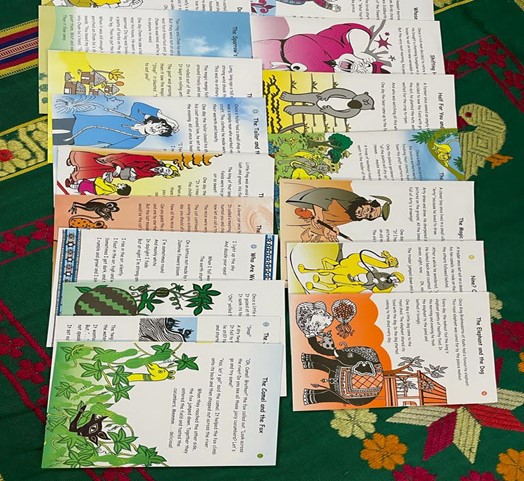
English Story Cards
Feedback and Media Coverage
There were articles written on ‘Kathai Aruvi’ story cards in leading newspapers ‘The Hindu’; ‘Economic Times’, ‘Times of India’ and Tamil Dailies such as ‘Dinakaran’ and ‘Dinamani’ and a weekly magazine ‘Kalki’ in the year of its publication 2003. More recently Hindu published an article in the year 2019 about the Kannada story cards –
https://www.thehindu.com/entertainment/art/telling-stories-putting-ideas/article30286560.ece
The English cards were appreciated in a Times of India news – https://m.timesofindia.com/city/coimbatore/a-trump-card-for-every-child/articleshow/97836292.cms
A research paper on impact of the Kathai Aruvi story cards in terms of the responses of the teachers and children in some of the districts of Tamil Nadu was published in 2007 issue of ‘Teachers Talk’, a journal published by TVS Education Society, Chennai.
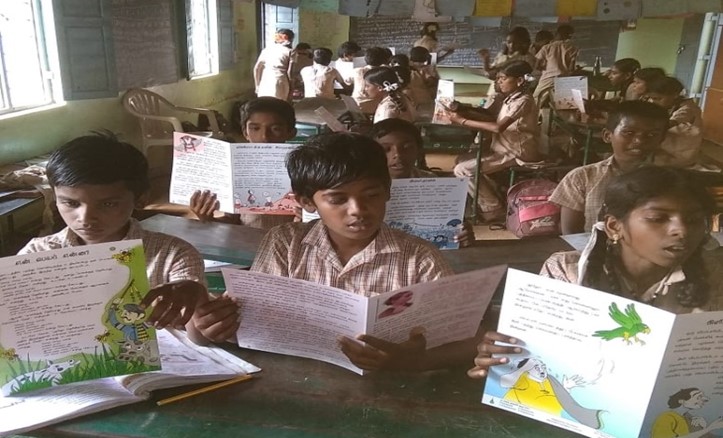 |
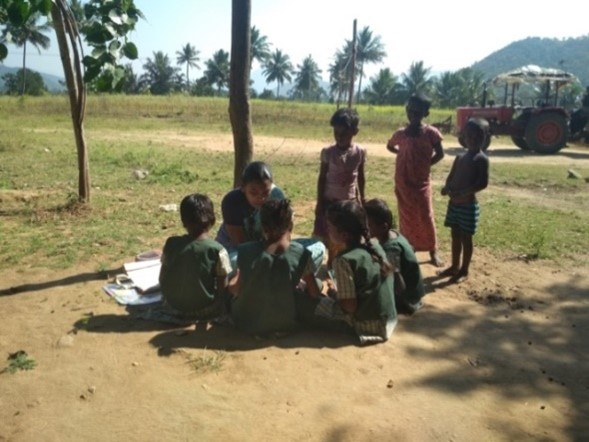 |
Children reading Kathai Aruvi(Tamil Nadu)
Feedback from teachers, parents and others who work with children’s education show a tremendous impact of these story cards. Children read the stories with eagerness and teachers find it a valuable tool to develop language skills, dramatization, drawing and creative skills. This was especially so during the Covid pandemic; one of the feedback we got from the North said:
“….During this lock down period schools have been closed for nearly two years. In these times it had become a challenge to connect children to reading and writing. Children were being promoted but they were unable to learn as per the levels in the classes. In such a situation we discussed with parents and started small community classes. In these community classes along with other teaching and learning material we used Katha Jharna too. These stories developed children’s ability to read, discuss, express their views, original writing skills in an unprecedented way. These cards are providing continuous support in promoting children’s reading and writing. With gratitude…”
Govt. Schools in Salem dist., TN have reported that Kathai Aruvi is motivating the children to write their own stories, create models, puppets, props and enact the stories
Several creative writing and storytelling workshops were conducted with children and teachers using the story cards over the years. In 2018, in collaboration with Sanchit Smriti, Lucknow, Kendriya Vidyalaya Sangathan conducted a series of storytelling workshops for KV teachers in the Northern Zone. The KV teachers responded enthusiastically to the Hindi story cards, Katha Jharna.
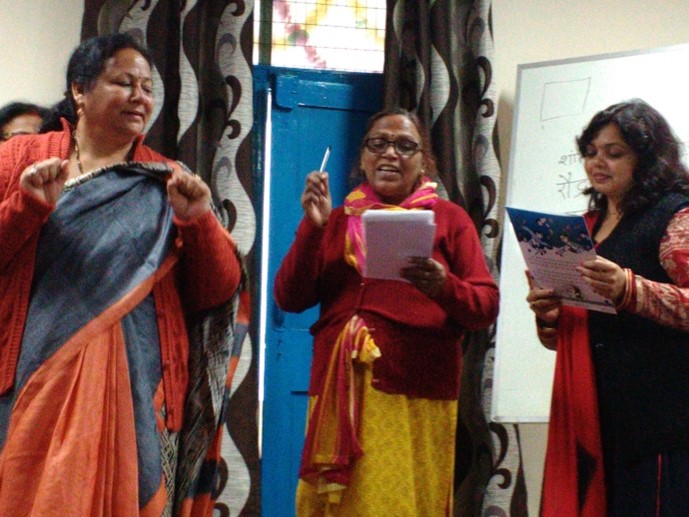 |
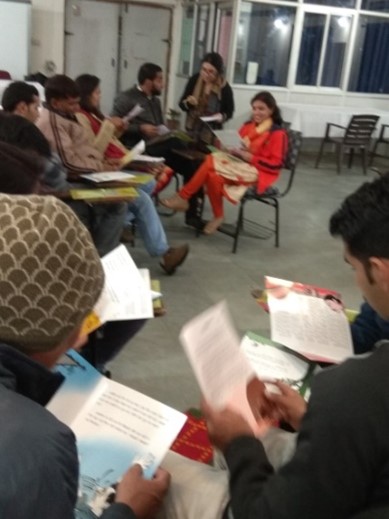 |
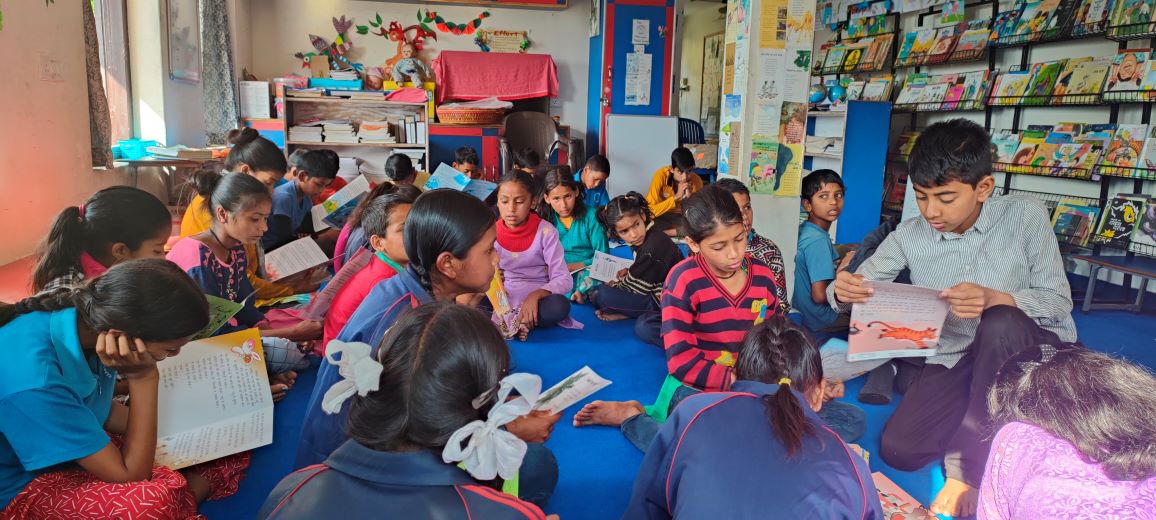
Reading Katha Jharna in a library, Nainital, Uttarakhand
A few overseas groups have also reported that they were using the story cards for teaching language to children.
During the Corona Pandemic when the schools were closed, there was considerable demand that the story cards be put online for children to read from their homes, and Katha Jharna in Hindi were put online - Click here to view them.
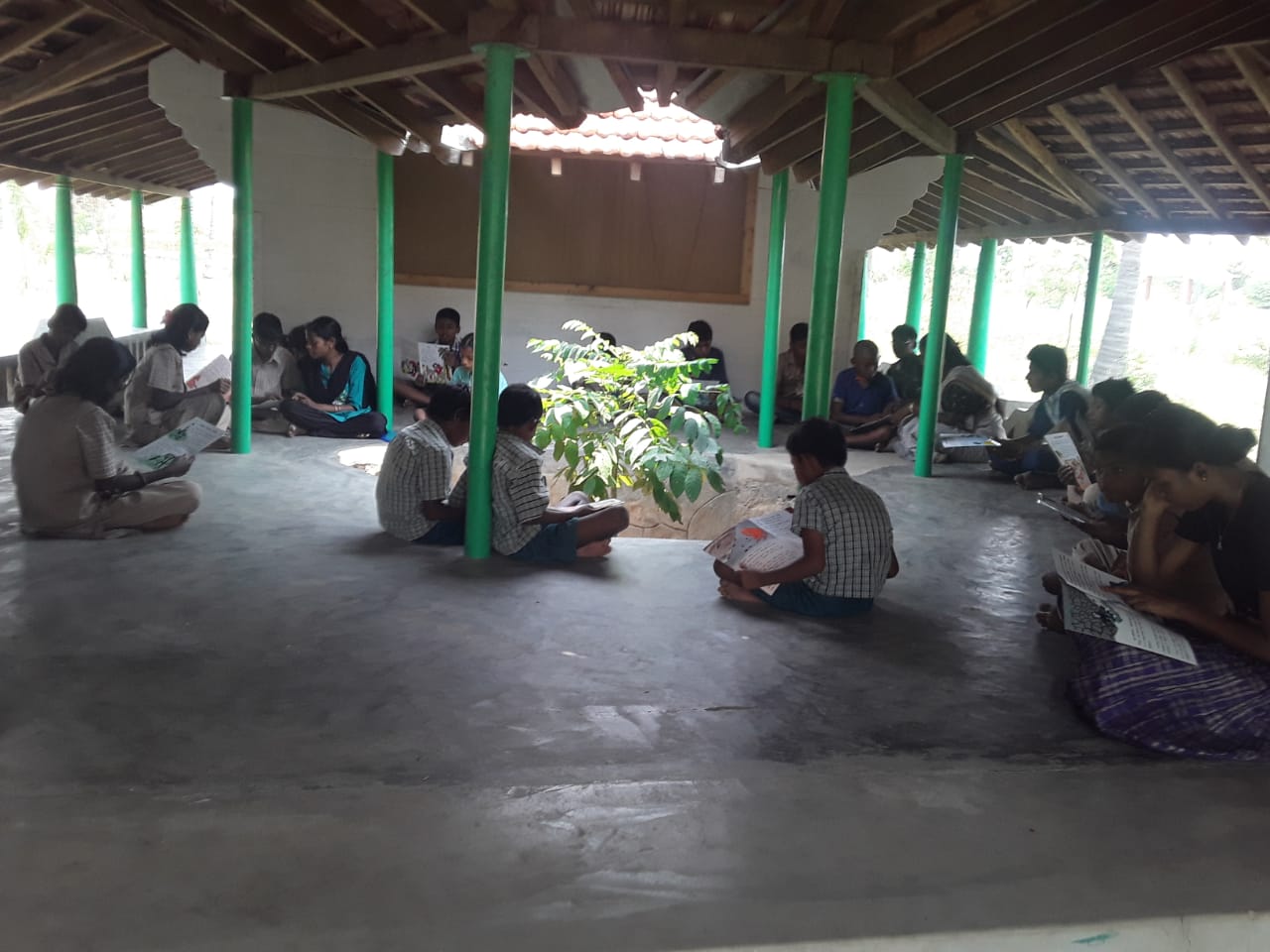 |
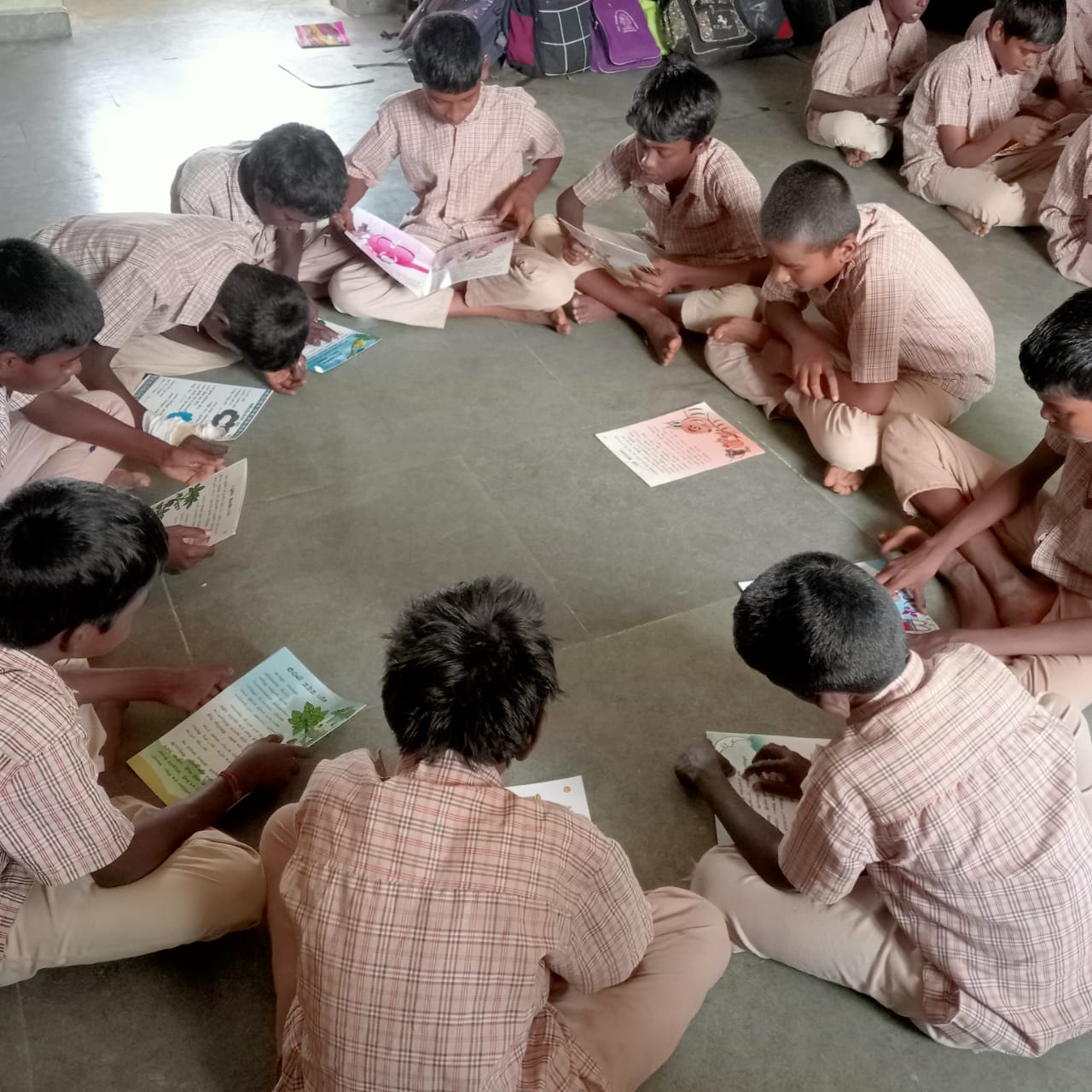 |
Some school children using the Story Cards in their schools
Funding of the Story Card Program – request for support
Rajalakshmi Srinivasan Memorial Foundation is bringing out the story cards and distributing the Story Cards to rural schools by networking with a wide range of NGOs and donors. But this is still far from what is required in a vast country like ours with thousands of schools. Given the expanding demand for the cards in multiple languages from different parts of the country, the Foundation needs additional resources, and we are seeking funding support from individuals and institutions. In order to reach one set of 100 laminated story cards to a school an amount of Rs.1400/ is needed and an entire class can use the material at the same time. An amount of 14 lakhs is needed for reaching 1000 schools. Donors can take up a whole cluster/block/district for distribution of the story cards sets to schools. Donations to the Foundation are tax exempt under the 80 G provisions of the Income Tax Rules, as well as we are approved to receive CSR funds by the Income Tax Department.